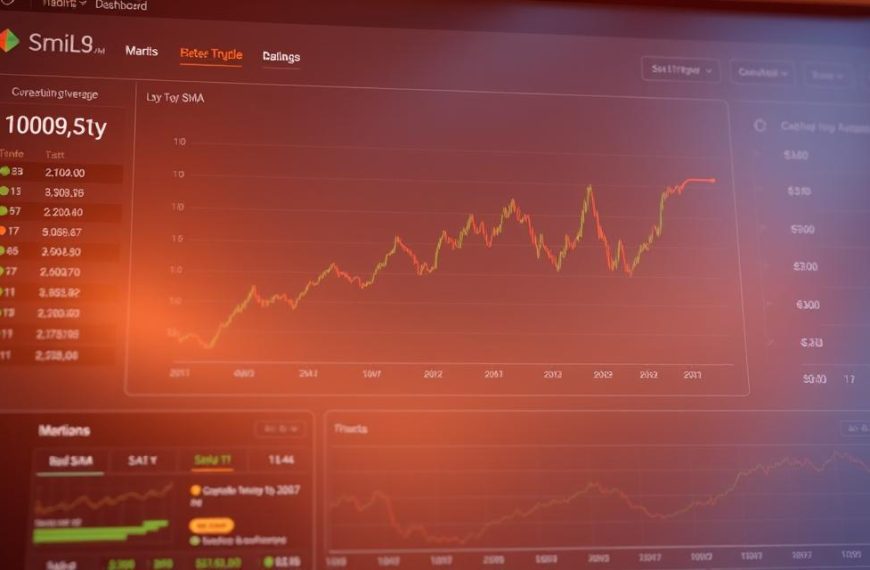Bitcoin is a revolutionary digital currency that captivates global financial markets. Its extraordinary price movements have transformed the cryptocurrency market. These dramatic fluctuations challenge traditional investment approaches1.
Bitcoin’s journey shows its complex nature. Its price has ranged from pennies to over $74,000 in the past decade2. The cryptocurrency’s value has surged about 50 times in recent years3.
Bitcoin volatility stems from several interconnected factors. The cryptocurrency market differs from traditional financial systems. Speculative trading, market sentiment, and technological developments drive rapid price changes2.
Scarcity significantly impacts Bitcoin’s price movements. The total supply is limited to 21 million coins. This constraint creates market tension, amplifying price fluctuations2.
Large investors, known as “whales”, can greatly influence prices. Their substantial trading activities can cause significant market shifts3.
The new nature of Bitcoin markets fuels its volatility. Regulatory uncertainties and media coverage can trigger immediate price shifts. Global economic events also play a role in these changes1.
Investors must navigate this complex landscape carefully. Thorough analysis and risk management strategies are essential for success in this market.
Understanding Bitcoin’s Volatility in the Digital Age
Bitcoin emerged in 2009 as the world’s first decentralised digital currency. This financial innovation introduced blockchain technology, creating a secure method of recording transactions4.
It established a transparent system across a global network. The cryptocurrency’s debut marked the start of a revolutionary digital breakthrough.
Bitcoin’s history shows a remarkable journey of financial transformation. Its dramatic price fluctuations have captured global attention. Bitcoin’s volatility has been a defining feature, challenging traditional financial market norms4.
Cryptocurrency Market Milestones
- Reached an all-time high of over $74,0004
- Current market capitalisation of approximately $700 billion5
- Fixed supply cap of 21 million coins4
Bitcoin’s financial market impact has been profound. Institutional investors have recognised its potential, with KPMG Canada adding it to their treasury5.
The digital asset has shown remarkable resilience. It has outperformed traditional investments over the past decade4.
Technological and Economic Significance
Bitcoin’s journey showcases a transformative period in financial technology. It has evolved from a niche experiment to a globally recognised asset.
Its volatility is trending downward as market liquidity improves4. Notably, the U.S. dollar has lost over 19% of its purchasing power in ten years.
Meanwhile, Bitcoin’s value has increased dramatically5. This contrast highlights the cryptocurrency’s growing importance in the financial landscape.
Supply and Demand: The Core Driver of Bitcoin Price Movements
Economic principles shape Bitcoin’s value in the cryptocurrency landscape. Understanding Bitcoin’s supply and demand offers insights into its price movements and market behaviour.
These factors reveal how Bitcoin’s market operates. They also explain why its price can change so dramatically.
The 21 Million Bitcoin Cap
Bitcoin has a fixed supply cap of 21 million coins. This scarcity mechanism influences its market value67.
The limited supply sets Bitcoin apart from traditional currencies. It also drives its potential as a deflationary digital asset.
Mining Halving Events
Bitcoin’s economic model includes periodic mining halving events. These events reduce new coin creation over time.
The most recent halving occurred on 19 April 2024. It reduced block rewards to 3.125 bitcoins6.
Halving events slow down Bitcoin’s supply growth. This can potentially trigger price appreciation.
- Reduces new Bitcoin generation
- Occurs approximately every four years
- Creates artificial scarcity
Market Liquidity Factors
Market liquidity is crucial for Bitcoin’s price dynamics. It affects price stability and investor confidence.
Bitcoin’s market capitalisation has seen significant shifts. It dropped from over 80% in 2017 to less than 57% by October 20246.
Bitcoin’s price can fluctuate dramatically. Daily variations can reach around $2,5007.
These price swings highlight the importance of understanding market liquidity. They also emphasise the impact of supply constraints on Bitcoin’s value.
What Caused Bitcoin to Fluctuate?
Bitcoin’s price moves due to various factors driving cryptocurrency volatility. The digital currency experiences dramatic swings because of complex market dynamics8. From January 2018 to June 2019, Bitcoin’s average daily price movement was 2.67%8.
Extreme fluctuations reached up to 16% on the upside and 18% on the downside8. These sharp changes highlight Bitcoin’s unpredictable nature in the financial world.
- Market Sentiment: Investor perceptions dramatically impact cryptocurrency prices9
- Regulatory Changes: Government policies can trigger significant price shifts9
- Technological Advancements: Network improvements influence investor confidence
Bitcoin’s volatility is truly remarkable. Its prices can surge or plummet by over 10% in a single day9. Tesla’s acceptance of Bitcoin as payment caused a 5% price increase.
However, their subsequent withdrawal led to a similar decline9. This shows how sensitive Bitcoin’s price is to company decisions.
| Factor | Impact on Bitcoin Price |
|---|---|
| Market Speculation | High Volatility |
| Institutional Investment | Significant Price Movements |
| Regulatory News | Immediate Price Reactions |
Geopolitical events can also greatly affect Bitcoin’s value. Wars and global economic uncertainties often reduce investor risk appetite9. This directly impacts cryptocurrency prices, causing further volatility.
Bitcoin’s unique features contribute to its price swings. Its capped supply of 21 million coins10 plays a crucial role. With about 19.6 million bitcoins in circulation10, scarcity drives its market value.
Institutional Investment and Market Sentiment
Bitcoin’s investment landscape has changed dramatically with institutional players joining in. Its market cap has hit $1 trillion, making it a significant asset class. Financial giants now see cryptocurrency as a valid investment strategy.
Major financial institutions are embracing Bitcoin in various ways. Goldman Sachs has reopened its cryptocurrency trading desk, offering Bitcoin derivatives. BlackRock, a top investment manager, is now among the largest Bitcoin holders.
Whale Investors and Market Dynamics
Whale investors greatly influence Bitcoin’s market sentiment. These large-scale investors can cause significant price movements through their trading. Institutional strategies now include Bitcoin as a hedge against inflation.
- Direct Bitcoin purchases through exchanges
- Bitcoin futures contracts
- Investment funds focused on cryptocurrency
Market Sentiment Indicators
Grasping market sentiment is key to understanding Bitcoin’s volatility. Institutional investments are helping to stabilise Bitcoin’s price and reduce market fluctuations11. Global inflation concerns have made Bitcoin an attractive store of value for institutions.
Trading Volume Patterns
Trading volume shows the level of institutional interest in Bitcoin. Regulated financial products are making it easier for institutions to invest in cryptocurrency. Bitcoin ETFs and custodial solutions have further legitimised institutional participation in the market.
Regulatory Environment and Government Policies
Bitcoin regulations are rapidly changing worldwide. Governments are trying to balance innovation and financial security in their cryptocurrency policies. In the United States, Bitcoin is legal but not recognised as legal tender.
Different countries have unique approaches to cryptocurrency governance:
- Japan officially recognised cryptocurrencies as property in 201712
- The European Union implemented Markets in Crypto Assets (MiCA) regulation in June 202312
- South Korea plans to introduce a 20% tax on cryptocurrency profits in 202512
Regulatory decisions can greatly affect Bitcoin’s market dynamics. Government influence has shown remarkable power in shaping cryptocurrency trajectories. China’s cryptocurrency business crackdown in November 2019 caused a significant Bitcoin price drop.
The regulatory landscape is perpetually shifting, creating both challenges and opportunities for cryptocurrency investors.
The SEC and CFTC play crucial roles in cryptocurrency oversight. The SEC monitors Bitcoin-related investments and derivatives. The CFTC categorises cryptocurrency as a commodity.
International teamwork is vital for developing comprehensive cryptocurrency policies. Over 100 organisations have joined talks to create strong regulatory frameworks. These include crypto exchanges, banks, and regulatory authorities.
Media Influence and Market Psychology
Media narratives and public perception shape the cryptocurrency landscape. Bitcoin market psychology shows how social media, news cycles, and investor sentiment influence prices13.
Social media platforms are powerful catalysts in cryptocurrency media influence. Investors experience psychological triggers that turn digital conversations into market reactions14.
Social Media’s Market Impact
- Rapid information dissemination
- Amplification of market sentiment
- Instant global communication channels
Celebrity endorsements can cause significant price fluctuations. When influential figures discuss cryptocurrencies, markets often experience substantial volatility13.
Psychological Market Dynamics
Investor psychology is crucial in cryptocurrency trading. Key psychological phenomena include:
- FOMO (Fear of Missing Out)
- Confirmation bias
- Recency bias
| Psychological Factor | Market Impact |
|---|---|
| Herd Mentality | Increases market volatility |
| Emotional Trading | Drives impulsive investment decisions |
Grasping these psychological mechanisms can help investors make wiser choices. It’s crucial in the unpredictable world of cryptocurrency trading13.
Social media and news cycles are not just reporting market movements—they are actively creating them.
Technical Analysis and Trading Patterns
Bitcoin technical analysis equips traders with robust tools to navigate cryptocurrency markets. These methods help predict price movements and grasp market psychology. Crypto chart analysis spans from 1-minute intervals to monthly perspectives.
Chart patterns are vital in cryptocurrency trading. Traders often study specific formations:
- Head and Shoulders pattern
- Double Top and Bottom patterns
- Cup and Handle formation
- Triangular chart configurations
Price prediction models use various technical indicators to evaluate market conditions. The Relative Strength Index (RSI) provides crucial insights into market trends15.
| Indicator | Market Signal |
|---|---|
| RSI > 70 | Overbought Conditions |
| RSI | Oversold Conditions |
| MACD Crossover | Potential Trend Change |
Traders using Bitcoin technical analysis should note these tools offer insights, not guarantees. Successful cryptocurrency trading blends technical analysis with fundamental market understanding.
Network Effects and Adoption Rates
Bitcoin’s success hinges on network effects and adoption rates. As more people use digital currencies, their acceptance grows rapidly16.
Merchant Acceptance Growth
Merchant acceptance has changed dramatically recently. Many businesses now recognise Bitcoin as a valid payment method.
From online shops to local cafes, cryptocurrency network effects are becoming clearer16.
- Online payment platforms expanding Bitcoin integration
- Retail chains adopting cryptocurrency payments
- Small businesses embracing digital currency transactions
Infrastructure Development
Strong infrastructure is vital for Bitcoin adoption. Better wallets, secure exchanges, and efficient payment processors have improved cryptocurrency transactions.
These advancements have made digital currency more accessible and user-friendly16.
| Infrastructure Component | Impact on Adoption |
|---|---|
| Advanced Wallet Technologies | Enhanced Security |
| Streamlined Exchanges | Easier Trading |
| User-Friendly Payment Processors | Simplified Transactions |
User Base Expansion
The cryptocurrency world has grown amazingly. From one digital currency in 2009, it expanded to over 5,000 by 202116.
The total market value surpassed USD 3 trillion. This shows significant investor interest and merchant acceptance16.
Bitcoin’s network effects continue to drive its potential as a transformative financial technology, with ongoing developments promising increased mainstream adoption.
Conclusion
Bitcoin’s journey showcases market volatility and technological innovation. Its price soared from zero to over 19,500 USD in December 201717. Investors must navigate this dynamic cryptocurrency ecosystem carefully18.
Bitcoin’s finite supply of 21 million coins creates scarcity18. Its value fluctuates based on tech developments, regulations, and global market sentiment17. Search interest and market perception also influence Bitcoin’s price significantly17.
The future of Bitcoin suggests ongoing evolution. Increasing adoption rates and institutional interest may stabilise the cryptocurrency. Halving events, regulatory changes, and tech innovations will shape Bitcoin’s path18.
Strategic investors should stay adaptable in this emerging digital asset class. Thorough research and a balanced approach are crucial for success. The cryptocurrency landscape demands constant vigilance and informed decision-making.
FAQ
What causes Bitcoin’s price to fluctuate so dramatically?
How do institutional investors impact Bitcoin’s price?
What role does media play in Bitcoin’s price volatility?
How do regulatory decisions affect Bitcoin’s value?
What is the significance of Bitcoin’s 21 million coin cap?
How do mining halving events influence Bitcoin’s price?
What technical factors contribute to Bitcoin’s price movements?
How does network adoption affect Bitcoin’s value?
What is the Fear and Greed Index in Bitcoin trading?
Are there limitations to predicting Bitcoin’s price?
Source Links
- https://river.com/learn/why-is-bitcoin-volatile/
- https://crypto.ro/en/news/understanding-the-factors-behind-bitcoins-dramatic-price-swings/
- https://www.bitcoinmagazinepro.com/blog/what-moves-bitcoin-key-factors-behind-the-latest-bitcoin-rally/
- https://www.bitcoinmagazinepro.com/blog/why-is-bitcoin-so-volatile-and-will-it-ever-stabilize/
- https://www.fidelitydigitalassets.com/research-and-insights/research-round-deep-dive-why-bitcoin-so-volatile
- https://www.investopedia.com/tech/what-determines-value-1-bitcoin/
- https://www.investopedia.com/articles/investing/052014/why-bitcoins-value-so-volatile.asp
- https://www.etoro.com/crypto/why-bitcoin-fluctuates/
- https://www.fidelity.com/learning-center/trading-investing/bitcoin-price
- https://www.vaneck.com/corp/en/news-and-insights/blogs/digital-assets/bitcoin-volatility/
- https://osl.com/academy/article/institutional-bitcoin-investments-what-you-need-to-know/
- https://www.investopedia.com/news/bitcoin-has-regulation-problem/
- https://blog.ueex.com/implications-of-crypto-market-fluctuations/
- https://kanga.exchange/the-psychological-significance-of-past-trends-in-cryptocurrency-market-analysis
- https://explore.m2.com/learn/what-is-technical-analysis-and-how-to-read-the-chart-patterns-in-crypto
- https://www.elibrary.imf.org/view/journals/001/2023/213/article-A001-en.xml
- https://www.econjournals.com/index.php/ijefi/article/download/6446/pdf/16316
- https://d-central.tech/why-do-bitcoin-prices-fluctuate-so-much/
















